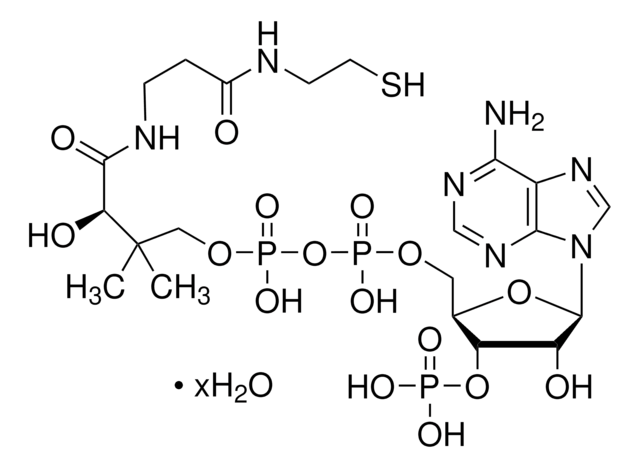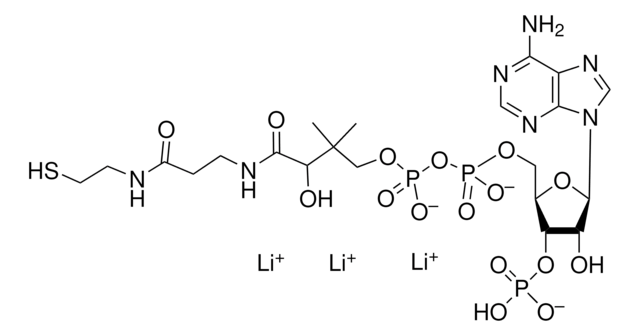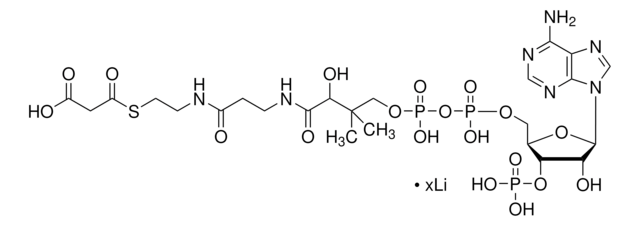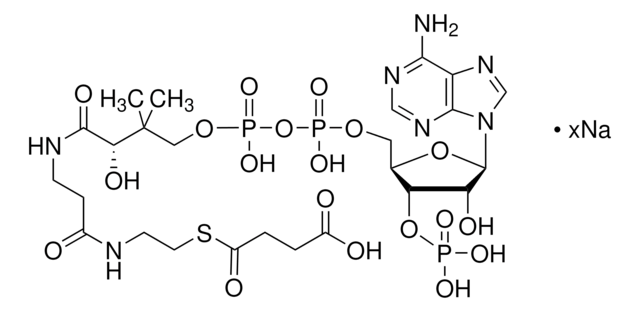A1765
S-Acetyl-coenzyme A synthetase from baker′s yeast (S. cerevisiae)
lyophilized powder, ≥3 units/mg protein
Synonym(s):
Acetate CoA ligase (AMP forming), Acetate thiokinase
Sign Into View Organizational & Contract Pricing
All Photos(1)
About This Item
Recommended Products
form
lyophilized powder
Quality Level
specific activity
≥3 units/mg protein
composition
Protein, 10-30% biuret
storage temp.
−20°C
Looking for similar products? Visit Product Comparison Guide
Application
S-Acetyl-coenzyme A synthetase from baker′s yeast (S. cerevisiae) has been used in the synthesis of adenosine 5′-tetraphosphate and adenosine 5′-pentaphosphate.
S-Acetyl-coenzyme A synthetase may be used to study various metabolic pathways, such as glycolysis, gluconeogenesis, pyruvate metabolism and CO2 fixation. It may also be used in gene expression studies.
Biochem/physiol Actions
Acetyl-coenzyme A synthetase catalyzes the production of acetyl-CoA. It is involved in histone acetylation in the nucleus. It may be involved in the growth of nonfermentable carbon sources such as glycerol. Acetyl-coenzyme A synthetase is induced by acetate, acetaldehyde and ethanol .
Packaging
Package size based on protein content.
Unit Definition
One unit will form 1.0 μmole of S-acetyl coenzyme A from acetate, ATP, and coenzyme A per min at pH 7.5 at 37 °C.
Physical form
Lyophilized powder containing stabilizers as potassium phosphate, sucrose, and reduced glutathione
Signal Word
Danger
Hazard Statements
Precautionary Statements
Hazard Classifications
Resp. Sens. 1
Storage Class Code
11 - Combustible Solids
WGK
WGK 1
Flash Point(F)
Not applicable
Flash Point(C)
Not applicable
Personal Protective Equipment
dust mask type N95 (US), Eyeshields, Gloves
Choose from one of the most recent versions:
Already Own This Product?
Find documentation for the products that you have recently purchased in the Document Library.
Customers Also Viewed
Adenosine 5'-tetraphosphate and adenosine 5'-pentaphosphate are synthesized by yeast acetyl coenzyme A synthetase.
Guranowski A, et al.
Journal of Bacteriology, 176(10), 2986-2990 (1994)
Guillaume Baptist et al.
Nucleic acids research, 41(17), e164-e164 (2013-07-31)
We have developed a new screening methodology for identifying all genes that control the expression of a target gene through genetic or metabolic interactions. The screen combines mutant libraries with luciferase reporter constructs, whose expression can be monitored in vivo
Sergio Renilla et al.
Applied microbiology and biotechnology, 93(5), 2109-2124 (2011-09-02)
Impairment of acetate production in Escherichia coli is crucial for the performance of many biotechnological processes. Aerobic production of acetate (or acetate overflow) results from changes in the expression of central metabolism genes. Acetyl-CoA synthetase scavenges extracellular acetate in glucose-limited
Saurabh Sahar et al.
The Journal of biological chemistry, 289(9), 6091-6097 (2014-01-16)
The circadian clock regulates a wide range of physiological and metabolic processes, and its disruption leads to metabolic disorders such as diabetes and obesity. Accumulating evidence reveals that the circadian clock regulates levels of metabolites that, in turn, may regulate
Sara Castaño-Cerezo et al.
Molecular microbiology, 82(5), 1110-1128 (2011-11-09)
Lysine acetylation is a well-established post-translational modification widely conserved and distributed in bacteria. Although multiple regulatory roles have been proved, little is known about its regulation. Here, we present evidence that the transcription of the Gcn5-like acetyltransferase YfiQ of Escherichia
Our team of scientists has experience in all areas of research including Life Science, Material Science, Chemical Synthesis, Chromatography, Analytical and many others.
Contact Technical Service









